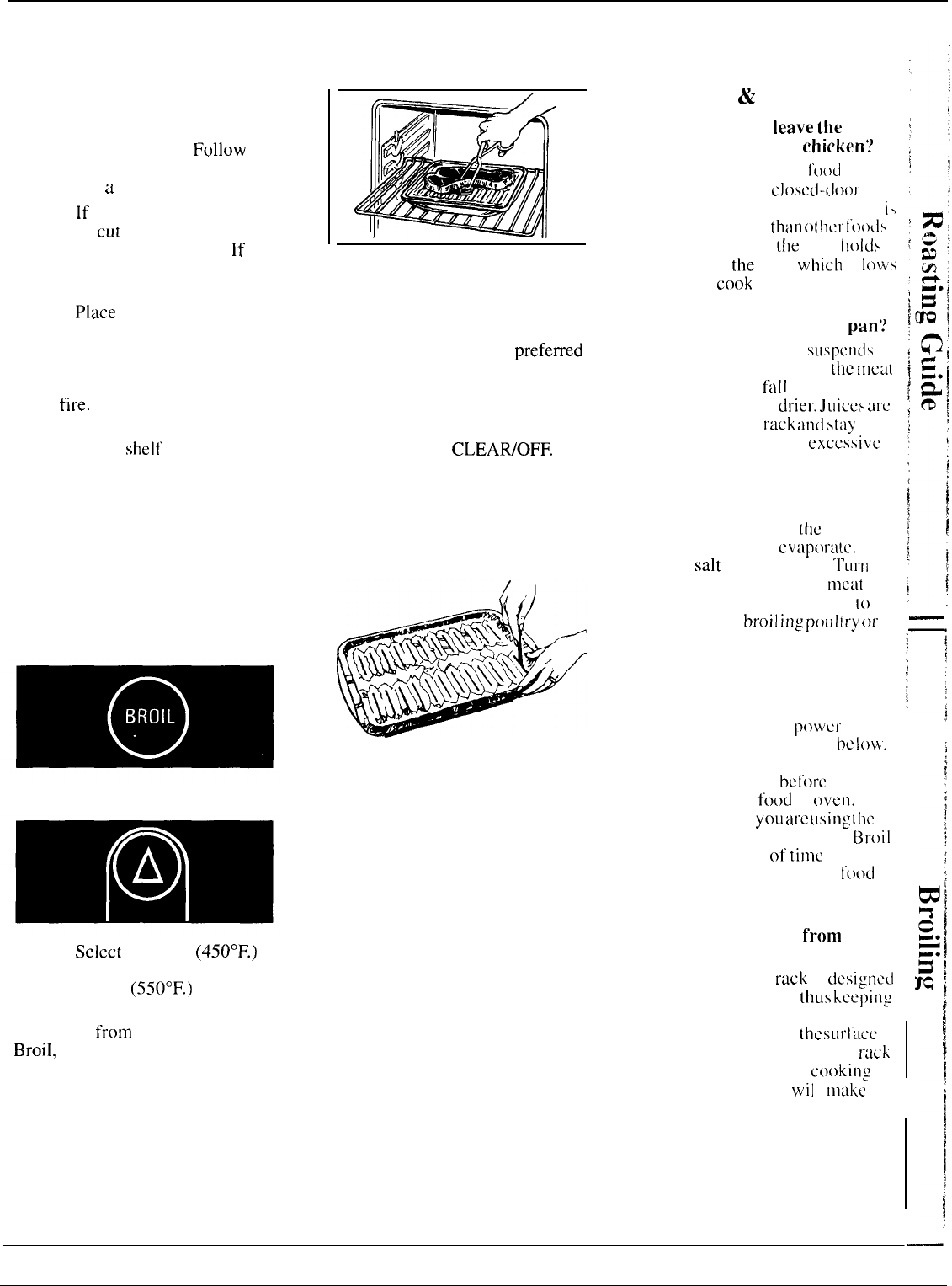
Broiling
Broiling is cooking food by intense
radiant heat from the upper unit in
the oven. Most fish and tender cuts
of meat can be broiled.
Follow
these steps to keep spattering and
smoking to
a
minimum.
Step 1:
If
meat has fat or gristle
near edge,
cut
vertical slashes
through both about 2“ apart.
If
desired, fat may be trimmed,
leaving layer about 1/8” thick,
Step 2:
Place
meat on broiler rack
in broiler pan which comes with
range. Always use rack so fat drips
into broiler pan; otherwise juices
may become hot enough to
catch
fire.
Step 3: Position shelf on
recommended
shelf
position as
suggested in Broiling Guide. Most
broiling is
done on C position, but
if your range is connected to 208
Volts, you may wish to use a
higher position.
Step 4: Leave door open to the
broil stop position (except when
broiling chicken). The door stays
open by itself, yet proper temperature
is maintained in the oven.
Step 5: Press BROIL pad.
Step 6:
Select
LO Broil
(450°F.)
by tapping INCREASE pad once.
Select HI Broil
(550°F.)
by tapping
INCREASE pad twice.
To change
from
HI Broil to LO
Broil,
press the BROIL pad then
tap DECREASE pad once.
Step
7: Turn food only once
during cooking. Time foods for
first side per Broiling Guide.
Turn food, then use times given for
second side as a guide to
prefemed
doneness. (Where two thicknesses
and times are given together, use
first times given for thinnest food.)
Step
8: When Broiling is
completed press
CLEAWOFF.
Serve food immediately, and leave
pan outside oven to cool during
meal for easiest cleaning.
Use of Aluminum Foil
You can use aluminum foil to line
your broiler pan and broiler rack.
However, you must mold the foil
tightly to the rack and cut slits in it
just like the rack.
Without the slits, the foil will
prevent fat and meat juices from
draining to the broiler pan. The
juices could become hot enough to
catch on fire. If you do not cut the
slits, you are frying, not broiling.
Questions
&
Answers
Q. Why should 1
leave
the
door
closed when broiling
chicken:)
A. Chicken is the only
I’OOCI
recommended for
closed-(loor
broiling. This is because chicken
ii
relatively thicker
thun
other
l“()(>~ls
you broil. Closing
the
door
Ilolds
more heat in
the
oven
which
al
I(>ws
chicken to
cook
evenly throughout.
Q. When broiling, is it necessary
to always use a rack in the
pan’!
A.
Yes. Using the rack
suspcn(ls
the meat over the pan. As
the
meat
cooks, the juices
fall
into the pan,
thus keeping meat
drier.
Juices
ut’c
protected by the
rack
and
s[ay’
cooler, thus preventing
exccssivc
spatter and smoking.
Q. Should
I salt the
meat
before
broiling?
A. No. Salt draws out
the
juices
and allows them to
evapora~e.
Always
salt
after cooking,
“]’LIII1
meat with tongs; piercing
meat
with a fork also allows juices
10
escape. When
broil
ing
poul[ry
or
fish, brush each side often
with butter.
Q. Why are my meats not turning
out as brown as they should’?
A. In some areas, the
p(~wcr
(voltage) to the range may
bc
Ic)vv.
In these cases, preheat the broil
unit for 10 minutes
bel’ore
placing
broiler pan with
food
in
oven.
Check to see if
yOLI
are
using
(he
recommended shelf position.
[3roil
for longest period of
time
indicated
in the Broiling Guide. Turn
l’~)(~d
only once during broiling.
Q. Do 1 need to grease my broiler
rack to prevent meat
f’rorn
sticking?
A. No. The broiler
rack
is
dcsigne~l
to reflect broiler heat,
thus
keeping
the surface cool enough to prevent
meat from sticking to
the
sLIrl’acc.
However, spraying the broiler
rack
lightly with a vegetable cookin:
spray before cooking
wil
I
nlake
cleanup easier.
21


















